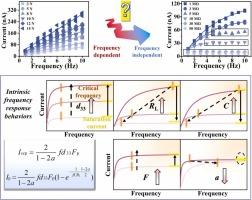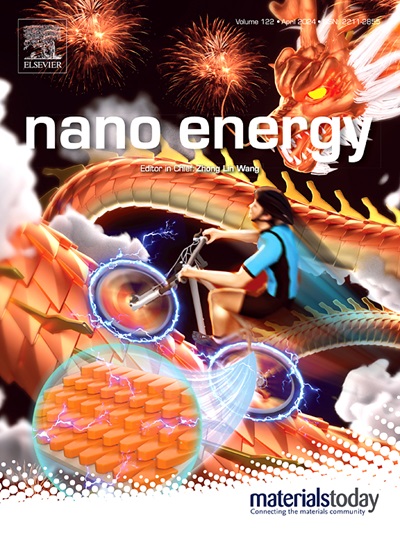解码压电输出电流的固有频率响应行为,用于先进的传感和监测应用
IF 17.1
1区 材料科学
Q1 CHEMISTRY, PHYSICAL
引用次数: 0
摘要
压电材料(PEMs)可以将机械能转化为电能。为了优化用于智能传感、人体监测和医疗应用的PEMs和设备,进行了大量的工作,然而,它们在不同应用频率下的机电行为仍不清楚。本文研究了无铅和含铅电火花器件的压电输出电流频率响应特性。结果表明,在短路条件下,输出电流与频率呈线性关系,且斜率随加载力F和压电系数d33的变化而变化。然而,当施加负载电阻(RL)时,显示出非线性关系:电流随频率增加,达到临界点,随后趋于平稳。饱和电流受F、RL、d33和器件电容(C)的影响,临界频率与RL、C和作用距离有关。PEMs的这种基本行为与麦克斯韦位移电流推导一致,并且得到了电路仿真和物理建模的良好支持。这些结果的普遍性通过铅基PEMs得到进一步证实。开路电压不受f的影响,而负载电压表现出与负载电流相同的非线性频率响应。将这些发现与机器学习相结合,实现了人体姿态监测和机器人运动识别。本研究为深入了解电磁铁中机电转换的固有频率响应行为提供了依据,并为新兴的压电传感和监测应用提供了指导。本文章由计算机程序翻译,如有差异,请以英文原文为准。

Decoding the intrinsic frequency response behaviors of piezoelectric output current toward advanced sensing and monitoring applications
Piezoelectric materials (PEMs) can convert mechanical energy into electrical energy. Substantial works were performed to optimize PEMs and devices for smart sensing, human monitoring, and medical applications, however, their electromechanical behaviors under such scenarios with different applied frequencies remain unclear. Here, the frequency response behaviors of piezoelectric output current are revealed based on lead-free and lead-based PEMs toward advanced applications. The results show a linear relationship between output current and frequency under short-circuit condition, with the slope varying according to loading force (F) and piezoelectric coefficient (d33). However, when a load resistance (RL) is applied, a nonlinear relationship is shown: the current increases with frequency, reaches a critical point, and subsequently levels off. The saturation current is influenced by F, RL, d33, and device capacitance (C), while the critical frequency is related to RL, C, and action distance. This fundamental behavior of PEMs aligns with Maxwell's displacement current deducing and is well-supported by circuit simulations and physical modeling. The universality of these results is further confirmed through lead-based PEMs. Open-circuit voltage is unaffected by f, while load voltage exhibits the same nonlinear frequency response as load current. Applying these findings by combining machine learning, human posture monitoring and robot motion recognition were achieved. This work gives a deep understanding of intrinsic frequency response behaviors of electromechanical conversion in PEMs and guides the emerging piezoelectric sensing and monitoring applications.
求助全文
通过发布文献求助,成功后即可免费获取论文全文。
去求助
来源期刊

Nano Energy
CHEMISTRY, PHYSICAL-NANOSCIENCE & NANOTECHNOLOGY
CiteScore
30.30
自引率
7.40%
发文量
1207
审稿时长
23 days
期刊介绍:
Nano Energy is a multidisciplinary, rapid-publication forum of original peer-reviewed contributions on the science and engineering of nanomaterials and nanodevices used in all forms of energy harvesting, conversion, storage, utilization and policy. Through its mixture of articles, reviews, communications, research news, and information on key developments, Nano Energy provides a comprehensive coverage of this exciting and dynamic field which joins nanoscience and nanotechnology with energy science. The journal is relevant to all those who are interested in nanomaterials solutions to the energy problem.
Nano Energy publishes original experimental and theoretical research on all aspects of energy-related research which utilizes nanomaterials and nanotechnology. Manuscripts of four types are considered: review articles which inform readers of the latest research and advances in energy science; rapid communications which feature exciting research breakthroughs in the field; full-length articles which report comprehensive research developments; and news and opinions which comment on topical issues or express views on the developments in related fields.
 求助内容:
求助内容: 应助结果提醒方式:
应助结果提醒方式:


